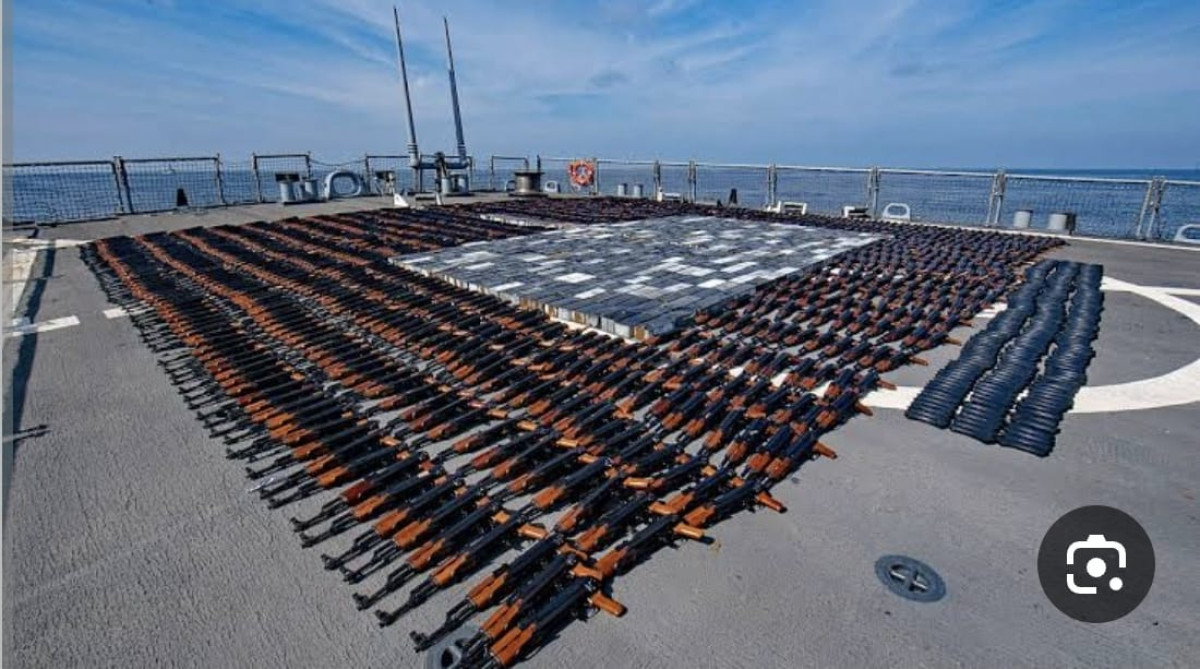Can Washington Finally Halt Arms Smuggling to the Houthis?
- 03 Mar 2024


The United States continues its military operations targeting sites associated with the Houthi "Ansar Allah" movement in Yemen, often in collaboration with other nations, notably Britain. However, despite the ongoing operations initiated on January 12, 2024, they have yet to effectively curtail the attacks launched by the movement in the Red Sea since November 19, 2023.
Consequently, Washington has escalated its efforts to compel the movement to cease its attacks in the Red Sea. This included reclassifying the group as a "global terrorist organisation" on January 17 and implementing stricter measures to counter weapons smuggling, particularly those originating from Iran, as confirmed by Washington.
Its latest actions in this regard occurred on February 15, when the US Central Military Command disclosed that a US Coast Guard vessel in the Arabian Sea had intercepted a weapons shipment destined from Iran to Houthi-controlled territories in Yemen. This seizure took place on January 28.
Against this backdrop, on February 23, the US Department of Justice filed criminal charges against four individuals holding Pakistani identity cards. These charges are connected to "intentionally and illegally transporting a warhead on board a sailboat intended for use by the Houthis in attacking ships at sea." Additionally, they are accused of providing false information to the US Coast Guard regarding the vessel's crew and cargo during boarding. If substantiated, these individuals could face imprisonment for terms ranging from 5 to 20 years.
While the measures enacted by the United States of America do not represent a novel approach, as the seizure of arms shipments from Iran to Yemen has been previously announced, their significance and momentum are heightened by the timing context in which they occurred.
These measures were implemented amid escalating tensions between the United States of America and Israel on one side and Iran, along with armed militias in countries such as Iraq, Syria, Lebanon, and Yemen on the other. This occurred against the backdrop of a war initiated by Israel in the Gaza Strip. Notably, the Qassam Brigades, the military arm of the Hamas movement, launched Operation "Al-Aqsa Flood" on October 7th, further exacerbating the regional dynamics.
Furthermore, and arguably most significantly, these measures coincided with direct involvement by the United States of America in the escalating military confrontation with the Houthi "Ansar Allah" movement.
Prior seizures of arms shipments occurred within the context of the internal military conflict in Yemen, during which Washington did not take robust measures to dissuade the movement. The movement, accused by the international community of seizing power and overthrowing constitutional legitimacy, persisted in its military operations both within and outside Yemen.
Here, the discernible shift in the US policy towards events in the Red Sea, rather than specifically in Yemen, prompts two primary questions:
Firstly, has the United States of America established a consistent policy towards developments in this region, which garners significant regional and international focus due to its crucial strategic positioning?
Secondly, does Washington possess the determination to earnestly tackle arms smuggling operations into Yemen to effectively halt them on a near-permanent basis?
Addressing these two inquiries necessitates primarily assessing the new approach embraced by the United States of America concerning the escalation in the Red Sea. This assessment hinges on three primary determinants:
U.S. actions and official statements underscore a clear limitation to the mission conducted in the Red Sea by the United States of America. The primary objective appears to focus on pressuring the Houthi "Ansar Allah" movement to cease its assaults on both commercial and military vessels navigating the region. Notably, this initiative does not extend to diminishing the movement's military capabilities.
This strategic restraint may elucidate why the United States refrained from resorting to military measures to address these capabilities, even in the face of threats posed by the movement's armaments, which were evident prior to their deployment in attacks on Red Sea vessels starting November 19. Such reticence persisted despite the vulnerability of Washington's regional allies to potential disruptions in Yemen.
Essentially, the United States opted not to intervene directly against perceived threats posed by the Houthi movement until these threats directly impacted US and Israeli interests. The Biden administration reasoned that the movement's persistent targeting of regional commerce could catalyse crises with far-reaching global implications, including price hikes in goods, disruptions to supply chains, and potentially elevated oil and gas prices. This concern is amplified by the fact that 13% of global trade annually transits through the Bab al-Mandab Strait.
It is plausible that the US administration anticipated its initial military strikes, conducted in collaboration with Britain on January 12, totalling 73 strikes, would compel the "Ansar Allah" movement to cease its assaults in the Red Sea.
Specifically, the US administration based its strategy for managing the escalation of the movement on the assumption that it would emulate the behaviour of other armed militias in various countries, such as Lebanese Hezbollah and Shiite militias in Iraq and Syria. These groups demonstrated a propensity to restrain or halt attacks against US and Israeli interests following escalated US military presence near their operational theatres. This pattern was observed during the deployment of aircraft carriers "USS Eisenhower" and "USS Gerald Ford" to the eastern Mediterranean region at the onset of the Israeli war on Gaza. Additionally, the use of military force against militias in Iraq and Syria in response to the attack on the US military "Tower 22 outpost" in northeastern Jordan on February 2 served as a precedent for such deterrence measures.
Unlike these entities, which either sought to confine escalations with Israel within certain boundaries to avoid disrupting the existing balance or suspended attacks on US bases in Iraq and Syria, such as the Hezbollah Brigades in Iraq, the Houthi "Ansar Allah" movement did not halt its assaults. Instead, it escalated its aggression, targeting vessels to cause direct casualties. For instance, on February 22, the UK-owned ISLANDER vessel was attacked, resulting in injury to one of its crew members. Concurrently, attempts were made to target US warships, including the Sea Champion, a Greek-flagged and U.S.-owned bulk carrier which had been subjected to a missile attack three days prior.
In this context, it became evident to the United States that the dynamics in the Red Sea differ significantly from those in Lebanon, Syria, and Iraq. The timeline for the cessation of attacks by the Houthi "Ansar Allah" movement in this region remains uncertain. Consequently, Washington initiated an exploration of available options to address this challenge, ultimately settling on two primary strategies. The first strategy involved intensifying the frequency and scope of attacks on sites affiliated with the movement. This approach was exemplified by the joint offensive launched by Washington and London against 18 Houthi targets on February 24. The second strategy involves monitoring select arms shipments travelling from Iran to the movement's locations within Yemen. In this regard, Washington aims to accomplish two objectives. Firstly, it seeks to constrain the options available to the Ansar Allah movement in responding to ongoing developments in the region, thereby exerting pressure to cease its attacks. Secondly, it aims to apply pressure on Iran, particularly in light of its reluctance to intervene and compel the movement to halt its aggressive actions.
Notably, both Iran and the Houthi movement responded to these US measures with a rationale that anticipated minimal impact on the movement's ability to sustain attacks in the Red Sea, provided they did not significantly impair crucial aspects of its military capabilities.
Iran particularly emphasised, in its reaction to the US announcement regarding the arms shipment seizure, that the military capabilities of the Houthi "Ansar Allah" movement are entirely indigenous. This assertion aligns with Iran's consistent policy in addressing accusations of military support to various countries and entities, whether within the region - such as armed militias in Iraq, Syria, Lebanon, and Yemen - or globally, as seen with Russia.
The occurrence of US casualties serves as a pivotal factor, prompting the United States to adopt a more forceful approach towards certain developments unfolding in the region.
This dynamic is particularly evident in two instances. Firstly, following the attack on the US "Tower 22" outpost in northeastern Jordan on January 28, which resulted in the deaths of three US soldiers, Washington responded with robust military strikes targeting positions and prominent field commanders of certain armed militias, notably the Iraqi Hezbollah Brigades. Secondly, during the interception of an arms shipment destined for Yemen by the US Coast Guard, the US Central Command announced on February 15 the deaths of two members of the US Navy Special Operations Force.
This highlights a significant trend wherein US reactions tend to escalate in response to US casualties, placing the administration under considerable internal pressure to deliver military reprisals against the involved parties. However, such responses often prove transient, yielding swiftly to tactical calculations embraced by the US administration in managing ground-level developments. This pattern establishes a threshold for the extent of military intervention in response to these circumstances.
This observation sheds light on the rationale behind the US Department of Justice's decision to pursue criminal charges against four individuals of Pakistani nationality found aboard the dhow transporting weapons, during which two US Navy personnel killed amid the inspection process.
Intervention Boundaries:
The entirety of the aforementioned analysis may offer insight into the two previously posed questions. The US responses to developments in the Red Sea region indicate a lack of adherence to a steadfast policy in addressing the crises unfolding therein. Instead, it appears to adopt a transient approach aimed at compelling the Houthi "Ansar Allah" movement to halt its Red Sea attacks, reverting soon to the traditional approach employed since the onset of the Yemen crisis escalation.
Consequently, the United States' insistence on intercepting more arms shipments bound for Houthi locations reflects a temporary tactic to achieve objectives related to halting the attacks and applying additional pressure on Iran. There are no indications suggesting continued operations once Houthi attacks in the Red Sea cease.
In conclusion, the intricate interplay of various regional dynamics, coupled with the swift and direct ramifications of the Israeli war on Gaza and its extensions in Lebanon, Syria, and Iraq, compel Washington to adopt a temporary approach. This approach primarily seeks to safeguard its interests, alongside those of Israel, and to prevent the current war from escalating into a protracted or widespread regional conflagration, which would be incongruous with its current strategic calculations.
The stated views express the views of the author and do not necessarily reflect the views of the Center or the work team.
Comments